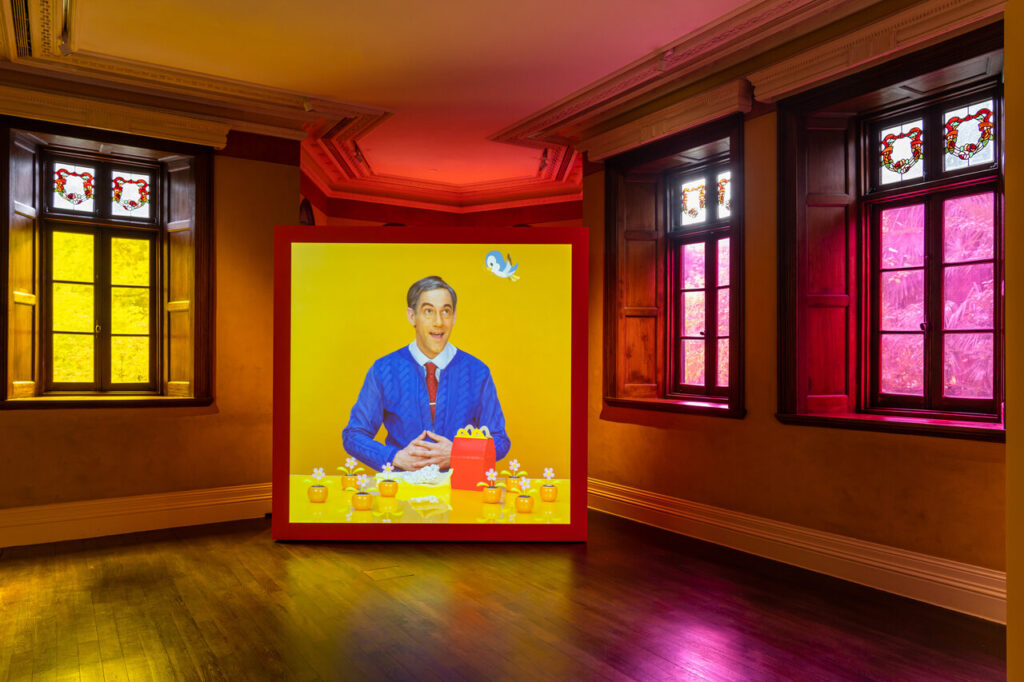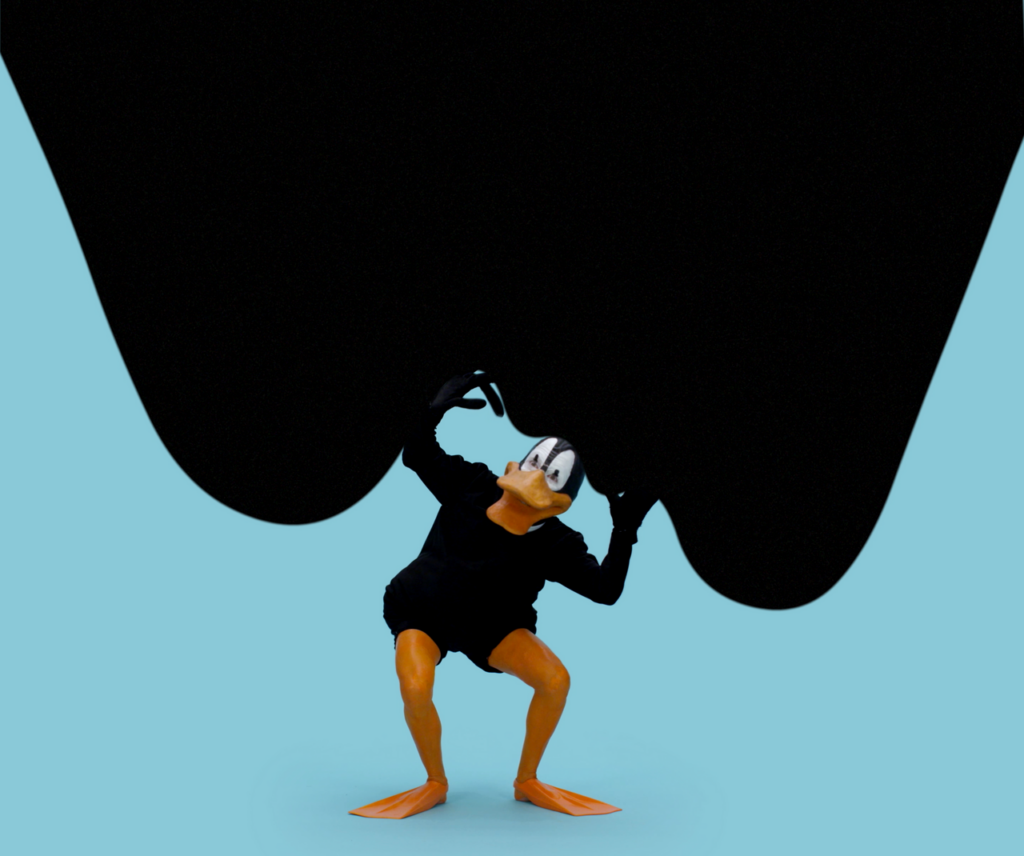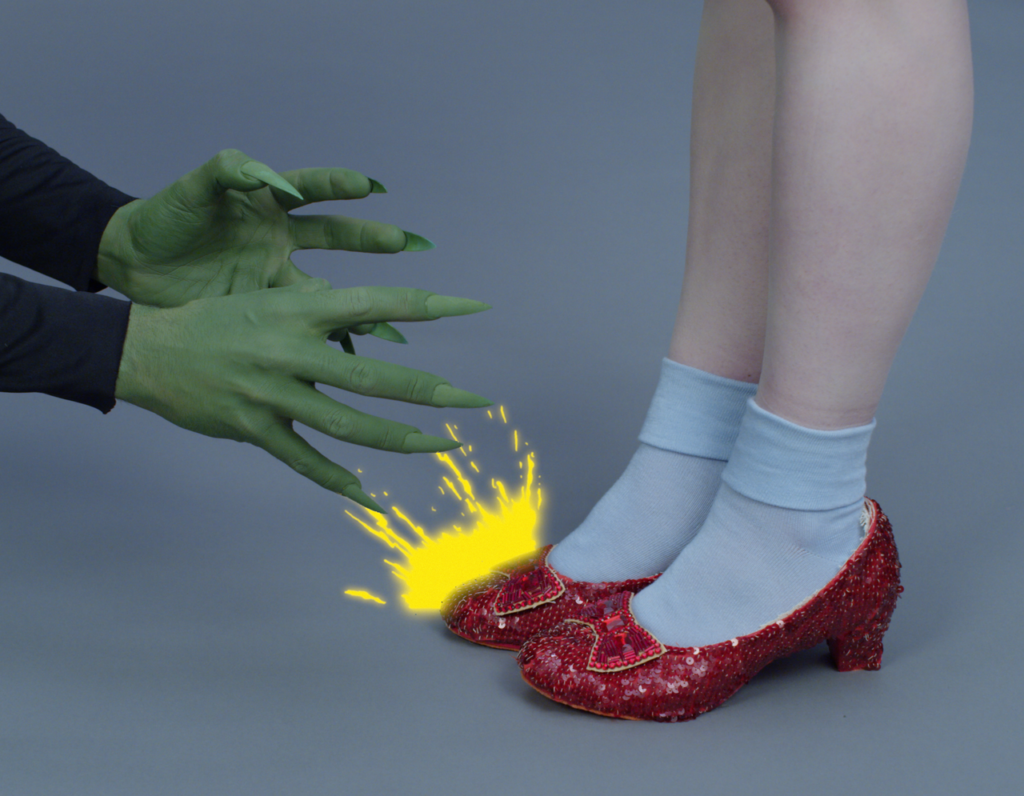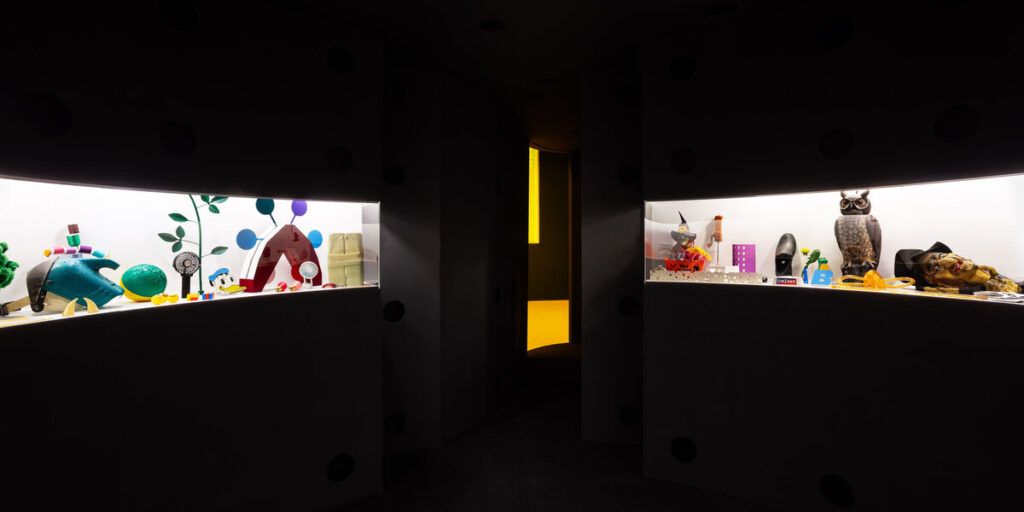Walking into Alex Da Corte’s exhibit on floor 2 of the MOCA was like walking into a childhood fever dream in the best way. You’re in a sunset-like environment with the blinds dimmed to a fleshy pink. Going in from the bright sun of the autumn and into a dimly lit room feels like being cocooned into your own childhood. Like a blanket had been placed over your memories and created a hazy image of the past. I was filled with a sense of nostalgia at the sight of familiar faces, but also, some sort of dread. And it made me realize this: nostalgia and dread are very much the same thing, and perhaps, we find ourselves stuck in it the further we grow from our childhood.
Alex Da Corte, “Rubber Pencil Devil,” 2018. Ear Worm, Installation view MOCA, Toronto, 2024.©Alex Da Corte. Photo: LF Documentation
“Rubber Pencil Devil”, the title of his 57-chapter film, seems to never end. Moving from screen to screen, watching different clips of this film, viewers see projections of recognizable images from pop culture stretched and warped into different versions of themselves. I found myself questioning whether or not I truly remembered these characters as they truly were – his Mr. Rogers’ costume was near-impeccable, and I found myself moved to tears at times when I would see him on the screen.
Alex Da Corte, “Rubber Pencil Devil,” 2018 (still). Ear Worm, Installation view MOCA, Toronto, 2024.©Alex Da Corte. Photo: LF Documentation
But there were other times where there was a sense of dread, like uncanny valley – his hyper-realistic portrayal of Popeye and Olive Oyl, Daffy Duck, and Bugs Bunny filled me with a sense of dread that I have only felt one other time in my life, and it was when I was a child at Chuck-E-Cheese waiting for one of the animatronics to close their metal jaws on me.
Alex Da Corte, “Rubber Pencil Devil,” 2018 (still). Ear Worm, Installation view MOCA, Toronto, 2024.©Alex Da Corte. Photo: LF Documentation
This distortion of memory made me truly question my own past and my own memories. Am I remembering it with rose-coloured glasses? Or is it profane and warped? Like a rubber pencil, our brains stretch and become almost elastic-like, reality and perception no longer a real thing. Da Corte brings us to a liminal space in this exhibit, one that I found myself returning to over and over again.
Alex Da Corte, “Rubber Pencil Devil,” 2018, (still). Ear Worm, Installation view MOCA, Toronto, 2024.©Alex Da Corte. Photo: LF Documentation
Da Corte uses memory as both a comfort and a disorienting facet of life. In a past exhibit titled “Die Hexe”, viewers were brought into a multi-storey installation akin to that of a house, but with something sinister happening. Tiles become warped, a credenza featuring glass objects now has hockey masks, there’s metal sculptures of a whale. Da Corte cited his grandmother’s dementia as an inspiration for this exhibit, and it seems to bleed into Ear Worm as well. Everything is recognizable, but something feels wrong. The film in itself does not follow a traditional storyline, repeating when you believe the story is moving forward, there’s a musical number put in there, and others are just plain sinister with Da Corte’s character staring right at the camera. This taps into the anxious instability of memory, unraveling the mind until the act of memory becomes a disorienting confrontation with something that can no longer be trusted. The sweetness of nostalgia curdles for the past that cannot return.
As viewers move through the screens, they are then met with a strange, curving building toward the back of the gallery. This is Da Corte’s “Mouse Museum (Van Gogh Ear)”, which offers a glimpse into his creative mind by providing fragments of his collection of props and other personal artifacts.
Alex Da Corte, “Mouse Museum (Van Gogh Ear)” 2024. Ear Worm, Installation view MOCA, Toronto, 2024.©Alex Da Corte. Photo: LF Documentation
This piece references Claes Oldenburg’s Mouse Museum, however, Da Corte transforms it into a single ear as a nod to Van Gogh, who famously cut off one of his ears during a hallucinatory episode. The interior is dark, illuminated only by a vitrine, but it is peaceful. Sounds of the film are drowned out, and it is only you and these artifacts. It was like being cocooned in the technicoloured mind of Da Corte himself, with these small fragments of his life all coming together to make one narrative.
This choice to make the “Mouse Museum” only one ear becomes a heavy metaphor for the relationship between creativity and the fragility of the mind. The ear, so close to the brain, serves as a gateway to audio perception while also sitting on the boundary between the outside and inner world. The brain has the power to generate creative thought and distort the memory, part of the tension in Da Corte’s work. This single ear becomes a symbol for how creativity and madness are often intertwined. Van Gogh, a genius of emotional expression of colour and form, suffered greatly from mental illness, leading his own reality to break down and warp. Similarly, Da Corte’s ear hints at how the mind, while capable of immense creativity, is also prone to lapses in perception of reality. The ear evokes this duality – it is a conduit of artistic expression, but also, a place where perception can become warped. This ear becomes a symbolic nod to the fine line between brilliance and chaos, between the artistic mind’s expansion yet its vulnerability to distortion.
Alex Da Corte, “Mouse Museum (Van Gogh Ear)” 2024. Ear Worm, Installation view MOCA, Toronto, 2024.©Alex Da Corte. Photo: LF Documentation
By engaging with bright colours, pop culture references, and playful forms, we feel this pull to nostalgia that verges on the line of unsettling terror that reminds us how fragile the past really is. The ear worm – a repetitive, inescapable thing that sticks in the tunnels of the mind – becomes a fitting metaphor for how memory loops endlessly, creating comfort and anxiety in equal measure. Ear Worm reflects the complexity of living with and without memories, offering a vivid portrayal of the dual forces of nostalgia and dread. We are invited to observe how memory, much like the objects in his “Mouse Museum”, is deeply personal and fragile. Ear Worm is an exhibit that fills the viewer with so much nostalgia and dread, but also, peace in knowing that the past cannot be changed, and the future is uncertain.
Victoria Filippo
Images are courtesy of MOCA
*Exhibition information: Alex Da Corte, Ear Worm, September 8, 2024 – January 26, 2025, Museum of Contemporary Art, 158 Sterling Rd, Toronto. Museum hours: Wed – Thu & Sat – Sun 11 am – 6 pm; Fri 11 am – 9 pm.






